



2018-02-09 Cranberry Tipworms, Aphids, and Beneficial Insects in the Post-Diazinon Era Diazinon was phased out in 2016. IPM in cranberry now relies on reduced-risk insecticides that kill specific insects, not all insects. Presentation by Sheila Fitzpatrick, Agriculture and Agri-Food Canada, Agassiz, BC. This Research Study has Two Objectives 1. Without pre-bloom Diazinon, do cranberry tipworms increase? 2. Without pre-bloom Diazinon, do aphids increase? Do their natural enemies increase? Study site is a Pitt Meadows farm that has been reliable for cranberry tipworms and natural enemies / beneficial insects since 2009. In 2016, the tipworm population decreased dramatically because of Movento applications in previous years. 1
2018-02-09 Sampling for tipworms, aphids and beneficial insects 2 fields 5 sampling areas / field Stake trap X X X 10 shoots X X per 15 metres X X X X Emergence X trap Movento in previous years reduced the number of larvae that overwintered. 2
2018-02-09 There were more overwintered parasitoids than tipworms. Parasitoids may have other hosts that were not killed by Movento in previous years. Numbers of eggs, larvae and pupae in the field did not increase during bloom, even though Diazinon was not applied to the field before bloom. 3
2018-02-09 More Ceraphron parasitoids than flying tipworms, but fewer than in 2016. Movento in 2016 probably killed tipworm larvae hosting parasitoid larvae … collateral damage. In answer to the first objective: Without pre-bloom Diazinon, do cranberry tipworms 1. increase? The overwintering populations of cranberry tipworms and their parasitoids were reduced by Movento applications in 2016 and previous years. During the first spring and summer without any Diazinon applications, the numbers of tipworm eggs, larvae and pupae in cranberry shoots did not increase. 4
2018-02-09 Second objective: Without pre- 2. bloom Diazinon, do aphids increase? Do their natural enemies increase? Main species of aphid is Ericaphis fimbriata . All stages feed on plant sap. a. nymphs (immatures); b. wingless adult female; c. winged adult female. Natural enemies of aphids Aphidius ericaphidus , the main species of parasitoid that attacks aphids on cranberry in BC. The adult female parasitoid is shown in all 3 photos. 5
2018-02-09 Natural enemies of aphids a . Aphidius female parasitoid attacks an aphid by bending her abdomen forward to insert an egg into the aphid body. The parasitoid egg hatches and the larva feeds on the aphid from within. b . Mummified body of a parasitized aphid. c . Inside the mummified aphid, the parasitoid larva fills the aphid’s body cavity. Natural enemies of aphids a . An adult syrphid fly (a.k.a. hover fly ) looks like a bee. Adults feed on pollen, nectar and sugary secretions of aphids. b . A syrphid egg (actual size 1 mm) laid near aphids by adult female syrphid. c . A syrphid larva, recently hatched, inserts mouthparts into an aphid and digests the aphid’s body contents. 6
2018-02-09 Natural enemies of aphids Ladybird beetle = ladybug a . A larva searches shoot tips to detect aphids (and tipworm larvae). b . The immobile pupal stage is where the larva undergoes metamorphosis to become an adult. c . The adult is also a voracious predator of aphids. Ladybug larvae were remarkably abundant, coincident with the peak and decline of aphids in June. 7
2018-02-09 In answer to the second objective: Without pre-bloom Diazinon, do aphids and their 2. natural enemies increase? Data and observations support the hypothesis that aphid populations increase in the absence of diazinon but are damped by populations of natural enemies, particularly ladybugs, which would have perished if diazinon had been applied. There was no plant damage due to aphid feeding. Acknowledgements FUNDING: Agriculture & Agri-Food Canada’s Growing Forward II Agri-Science Project in partnership with BC Cranberry Marketing Commission and Lower Mainland Horticultural Improvement Association. PEOPLE: • AAFC technician Sneh Mathur • Heidi van Dokkumburg at ES Cropconsult • Grower-cooperator Darshan Banns • University student research assistants! 8
Recommend
More recommend